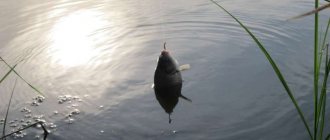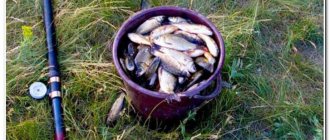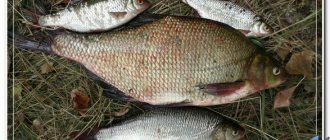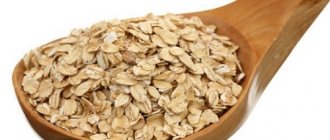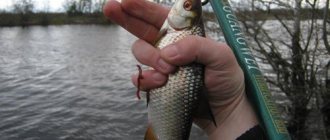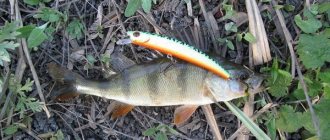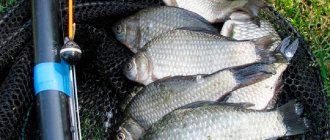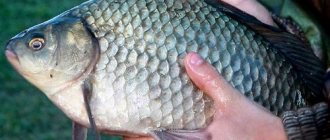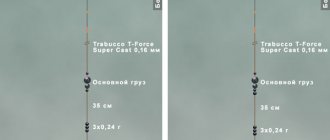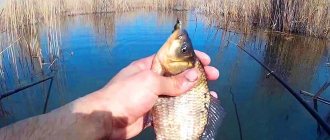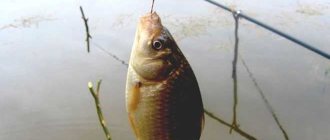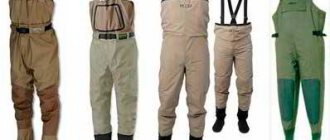Float 12/19/2019
664
It's a sad time! Ouch charm! - this is what the great Russian poet once wrote. Indeed, golden autumn is the most beautiful time of the year. There is probably no such riot of colors even in May. But I absolutely cannot agree that this time can be sad. The weather in mid-autumn is magnificent, and the fish caught is very diverse. Things are especially good now with predator catching. Perch, pike and pike perch are excellently caught using spinning rods and live bait tackle. And with a feeder, if you try, you can do some good fishing. While the water has not yet completely cooled down, there is a high probability of catching bluegills, breams and even crucian carp.
However, now I want to tell you about a completely different fishing experience. I have been sick with it for more than 40 years. And every year, as soon as the tops of the maples begin to turn yellow, I put off all my work and always devote several days to catching autumn roach with a float rod.
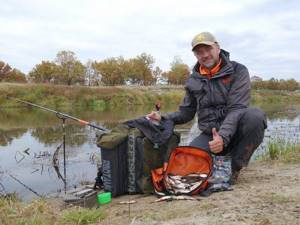
The roach is a notorious coward, and even in summer she is very distrustful of everything that makes her suspicious. For example, a roach will never accept bait, the color of which is very different from the color of the bottom of the reservoir. The same can be said about the structure of the gear. Roach and rough tackle are incompatible concepts. A little miscalculation with the correct animation of the bait, and you might not even get a bite. In cold autumn water, a roach's sense of self-preservation doubles or even triples. And this must be taken into account.
Rod
To catch autumn roach, it is enough to get a 5-7 meter rod. Most often I use the 7-meter Team Salmo TOURNAMENT POLE, and the 6-meter Team Salmo POLE.
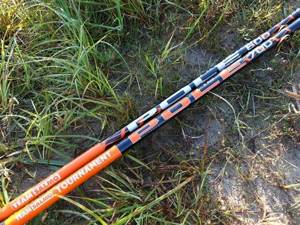
Both rods are very light and have a fast action. With a rod in which only the tip bends when casting, it is very easy to control equipment whose weight ranges from 2-4 grams.
If the main line is made half a meter shorter than the rod, then even with a strong side wind the presentation of the bait turns out to be almost like that of a plug. The bait on the hook can be held much slower than the current, or even stopped at the point you need. With a softer rod, you are unlikely to succeed in such a “trick”.
I use a short rod in cases where there is not much pressure from anglers on the shore, and the fish can be pulled to the shore with bait. A long rod comes in handy in cases where the shore is noisy, and in order to see the bite, you need to cast the tackle a little further than your neighbors. It is advisable that the rod for catching roach be equipped with a flexible monolithic whip of the “whalebone” type. Having a flexible tip allows me to work with the thinnest leaders, which in cold water significantly increases the chances of success.
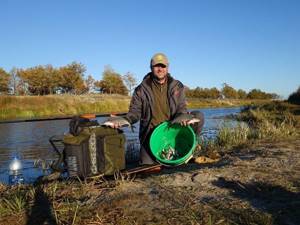
fishing line
As the main fishing line for catching autumn roach, I most often use the Team fishing line
Salmo Fluorocarbon thickness 0.16-0.18 mm. How is it an unusual choice? Agree. But I use this line not because it is invisible in the water (although this factor also contributes to the fact that in clear water the fish are less afraid of the equipment), but because it is stiffer compared to other monofilament lines. In windy weather, a stiff line makes fishing more comfortable.
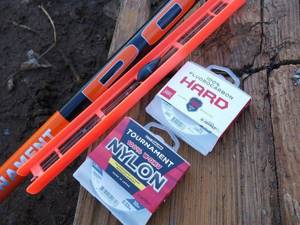
But I intentionally make leashes from soft Team Salmo TOURNAMENT NYLON fishing line with a diameter of 0.1 mm. It’s not scary that the strength of nylon fishing lines is slightly lower than their nylon counterparts (0.81 kg versus 1.09 kg) - for catching wary autumn fish, their amazing softness is much more important.
Baits for autumn fishing
Many floaters close the open water season with the autumn cold snap. It is believed that the fish moves to depth and becomes inactive. However, fishing experience in October - November shows that fishing for fish of various species can be even more productive than in other seasons.
Fishing in November with a dragonfly larva
Before freeze-up, when most of the aquatic flora dies off, the food supply of the rivers becomes noticeably poorer. In particular, dragonfly larvae find refuge in the debris at the bottom. This nymph is a real delicacy for many fish; perch, roach, rudd, chub, ide, bream, silver bream, and dace will not refuse it.
On the eve of freeze-up, due to constant rains, the current often intensifies, the direction of the underwater jets changes, and they suddenly begin to powerfully wash the algae that were previously located in calm areas.
As a result, the hiding dragonfly larvae are periodically washed out and, finding themselves in calmer areas, attract fish of various species. The fact that they are accustomed to this seasonal food and respond well to it is evidenced by the practice of many fishermen who successfully fish in late autumn on such rivers near Moscow as Pakhra, Protva, Lopasnya, Osetr and Dubna.
Excellent results are obtained by using dragonfly larvae when fishing with wire. Good places for this are usually behind capes, near riffles, below and above dams and bridges, at river bends and where there is a powerful rip current. The equipment should be launched taking into account the removal of the washed-out food to the adjacent calm water, where the fish waits for it in conditions that are comfortable for it. It is good to trace along the edges of fallen water lilies and other algae. The areas are chosen again taking into account the direction of the currents and the speed of parallel jets.
Prey fishing spots can sometimes be identified by splashes. Many people think that in late autumn the fish no longer splash. But that's not true. If the weather turns out to be sunny, even frosty, roaches and other cyprinids often actively rise in search of larvae carried by the current into the middle and upper layers of water.
For autumn fishing with dragonfly larvae on small rivers, a 6-7 meter carbon fiber rod equipped with rings and a spinning reel with a supply of fishing line is sufficient, which makes it possible to sometimes make a long release of the nozzle - up to 20-30 m. However, most often, having determined the catching point, the fisherman reduces The wiring length is up to 5–10 m. During this period, it is better to use a fishing line with a diameter of no more than 0.12 mm. Hook – with a long shank, dark color, No. 14–16. The dragonfly larva is worn under the breast, like a bloodworm. The number of larvae on the hook depends on their size. Sometimes one or two large brown larvae are enough, while up to 5 small green ones are put on a hook.
It is not difficult to collect dragonfly larvae in October-November. You just need to have wading boots, and best of all, a wading suit. If you know places where there were thickets of algae in the summer (in the fall they are visually difficult to detect), then go into the water and pluck an armful of dead stems from the bottom directly with your hands. It is better if they are together with the roots, on which there are larger larvae (usually brown). In addition, in the roots of algae you can find the clepsin leech, on which perch, roach, and chub bite well near fast streams below river dams.
No bait is needed when fishing with a dragonfly larva. Any use of plant mixtures or balls of soil with the addition of animal components does not bring success, but only scares away the fish. Even balls with dragonfly larvae mixed in them have this effect on her. You just need to look for the points where the fish are standing tightly.
Equipment
To make the bait on the hook look more believable to the fish, I only use a multi-point float loading scheme. For floats with a carrying capacity of up to 2 grams, this is a chain of pellets of decreasing mass. I load heavier floats, weighing 2.5-4 g, with one massive olive sinker, which contains up to 70% of the total mass of the equipment, and a chain of pellets of decreasing weight. Using a heavy weight makes my rigs less prone to overlapping. In addition, with a massive sinker, the bait on the hook reaches the working horizon faster. The leash must be short, 10-15 cm long. I traditionally select the hook size to match the size of the bait.
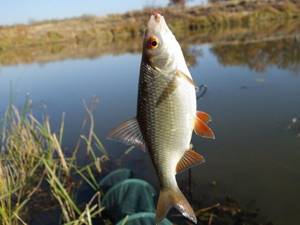
Most often, my rigs are equipped with hooks No. 14-16 made of thin wire.
Fishing with a fishing rod in autumn
Fish can be successfully caught with a line in the fall if you follow a few tips for fishing in cold water. In autumn, in still water, the fish will stick to deeper places, where the water is at least half a degree warmer than in the shallows.
It is almost impossible to catch carp and crucian carp in cold water near the shore in late autumn. They are grouped in deep places closer to the middle of the reservoir. But roach, chub, bream, rudd, silver bream, and bleak appear in depressions near the banks until the freeze-up, and can be caught with a fishing rod or plug.
Where is the best place to fish in cold water in the fall?
Coastal depressions on ponds usually occur in the area of the dam. Also a good place for autumn fishing with a fishing rod are ravines where streams flow into. As a rule, there are steep ledges of the bottom from water washouts. Also on the bends of the channel on the western bank there are rock and clay cliffs. There the channel approaches the very shore. It is necessary to examine the reservoir for the presence of such deep places.

Basic rules for fishing with a fishing rod in the fall
- Only lightweight equipment with thin fishing line is used. Fish bites in the fall are slow and weak; to distinguish them, you need sensitive gear.
- Bites from the bottom are rare, and they may not even be noticed. The nozzle must be hung at the very bottom. The float is given the opportunity to drift in the bait cloud or the rig is held with a fishing rod.
- The bait should dissolve well in water, creating an extensive odor field; the presence of rich particles is not allowed in it.
- The fish will have to wait on the bait for a very long time; its approach can last two hours or longer, and it is possible that the bite will only be in the afternoon.
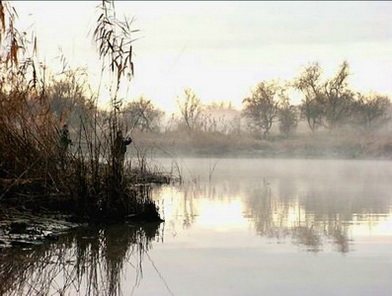
Fishing rod for autumn
Autumn fishing in cold water requires sensitive equipment. It can only be used on the plug and fly rod. Match tackle and Bolognese fishing rod, the equipment of which is designed for active fish, are not very suitable for fishing in late autumn.
In autumn, casting further away is necessary, so the length of the fishing rod, as a rule, should not be less than 7 meters, and preferably 8 - 9 meters. In order to confidently control the equipment with such a length, you need to choose soft-action rods.

Features of autumn equipment
You need stable floats, with a drop-shaped body and a long metal keel, since most likely you will have to fish in the wind. For calm, you need to change the float to a spindle-shaped one, as it is more sensitive.
For such a long fishing line in windy weather, with its smallest diameter, you will still need a significant load - from 2 grams. But with little wind, you need to use lighter equipment of 1 - 2 grams.
On a long line, simple weights are preferable. It is better to use a 3-weight scheme, with which you can also simulate a smooth immersion of the equipment.
With a leash of 10 - 15 cm, an additional weight of up to 0.1 g is used, then, 40 cm from the hook, an intermediate weight of 0.2 from the buoyancy of the float is placed, and a meter from the hook - the main load is made by a chain of weights.
The hook is placed only for bloodworms no larger than No. 18 made of thin wire.

Feeding
For fishing with a fishing rod in the pre-winter period, you need bait that quickly dissolves and easily spreads in the water. All bait particles should be small and not saturate the fish.
In cold water, diffusion slows down significantly. Mixing water with bait at the molecular level occurs very slowly, the smell spreads poorly. The fisherman's task is to accelerate the expansion of the cloud in the water.
To quickly create a fragrant cloudy cloud, you need bait that disintegrates almost instantly. This can be either a liquid composition (creamy) or a very dry ball of fine food.
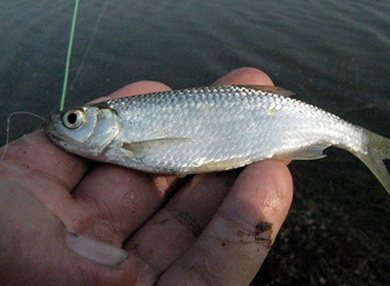
It is preferable to use liquid formulations. But it’s problematic to abandon them; you need to import them. There are no problems with the plug in this regard - you need to use a cup.
And with a fly rod, balls are mainly used. To mix bait that is too dry, you need to add handfuls of water in small portions and mix each time, preferably with a mixer (cordless screwdriver). As soon as it becomes possible to form a small ball, the food is ready to be thrown.
The smells should be very satisfying. If you make bait for autumn fishing with a fishing rod with your own hands, then you should use crushed bloodworms. It is dissolved in a small amount of water and the resulting composition is used to soak all the bait. By weight, crushed bloodworms should account for 15 - 20% of the total bait.
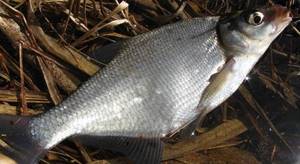
There should not be whole bloodworms in the bait for fishing with a fishing rod in the fall, otherwise you may not see a bite.
Also, homemade bait for fishing with a fishing rod in the fall should contain black soil, which creates a good turbidity, breadcrumbs, oatmeal, and milk powder (a little bit).
If the fish is clearly active, then you can add ground wheat or rye bread crackers for additional feeding. Their particles will be the most nutritious food, and can support a fattening flock.
The main bait for fishing with a fishing rod in the fall is bloodworm. As a rule, maggots in cold water do not give the best results. Sometimes, with baits that have a bready aroma, a good bait will be a weak dough made from flour, and sometimes from semolina.
On a reservoir, it is better for the fisherman to choose a leeward shore so that the equipment does not wash quickly to the shore, and, if possible, feed several places for casting. Fish do not rush to the cage in the fall, but the catch obtained in difficult fishing conditions is much more valuable.
Floats
The choice of float models in our time is large, but in order to tempt the cautious autumn roach to bite, you need to be very careful when choosing this accessory.
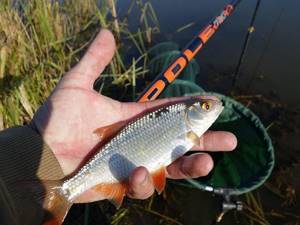
A modern float is more than a bite alarm. The presentation of the nozzle greatly depends on its choice. In calm weather, which is very rare in the fall, I use spindle-shaped floats. Such floats have amazing sensitivity. But in the wind, when there is a fairly strong wind current in the reservoir, the most popular models are floats with a low center of gravity. If such a float is loaded to the base of the antenna, the ring for passing the fishing line is 5-7 cm below the water level. Together with the ring, part of the main line is under water, and the drift of the entire equipment is significantly reduced. A float for catching autumn roach must have a thin antenna that is clearly visible on the surface of the water. And in order to see even the most careful bite, I use floats with antennas no more than 2 mm thick.
Fishing for chub in late autumn
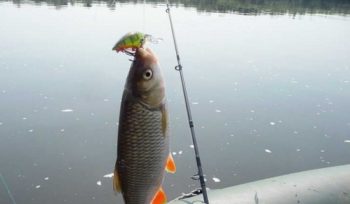
Fishing at this time requires the use of thin fishing line and baits that accurately copy the behavior of the fish. Also, in cold weather, individuals stay close to underwater shelters.
Features of fishing in September
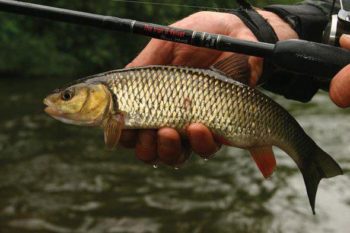
This is the most successful month for fishing, since the lack of food and the increased appetite of the chub force it to rush to any bait. At the same time, there is a decrease in the activity of individuals.
The best time for fishing is from morning to lunch. After 9 o'clock in the morning, the highest chub activity begins due to the fact that the sun warms up the water, and individuals rise to the top. You can catch fish at the beginning of the month with a regular float rod, and at the end - with the help of bottom tackle.
Fishing in October
This month, the chub lives both in depressions at the bottom and in places where trees and bushes hang over the water. Peak activity in October is midday. The best bait is spinning spoons. Their size should not be more than 2, most often it is 00, 0 or 1. Another option is a wobbler with greater depth. Baiting should be done in a coastal area.
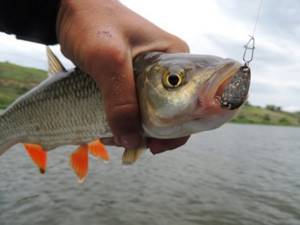
Chub fishing in November
This month, the chub is constantly in the depths or in cluttered areas. The fish are actively looking for shelter for the winter. Activity occurs in the afternoon. In coastal areas it becomes more difficult to catch chub; jig baits are used for fishing. A number of requirements are put forward to them:
- Size no more than 4 cm in length.
- The choice of vibrating tail or twister does not matter.
- You need to start fishing with dark colors, if there is no bite, switch to bright baits. Also, bright colors can be taken for fishing in troubled waters or at night.
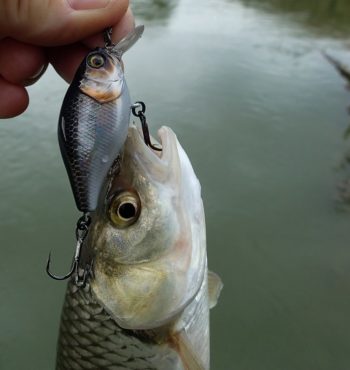
In November, the chub lives along steep banks with lush vegetation; individuals are attracted by quiet currents. Experienced fishermen also note that before the first ice appears, the chub’s fear of a hungry winter intensifies, it becomes accessible and actively devours any bait.
The chub is a strong and semi-predatory, cunning and cautious fish. The specifics of autumn fishing are determined by seasonal changes in the behavior of individuals. Due to lack of food, the chub goes into the depths in search of fry, larvae, and crustaceans.
The choice of gear and bait is influenced by the knowledge of the fisherman, the characteristics of the chosen reservoir, the air temperature and the specific autumn month.
Are you sitting correctly?
Trying to catch autumn roach standing at the very edge of the water is a waste of time. Most often, the prey of such an angler are roaches the size of an index finger. It's all about the natural caution of this fish, which sees the silhouette of a person and is afraid to come close to the shore.
If you fish from a sitting position, and even move a meter and a half away from the water’s edge, the fishing result will be much better. If you follow the basic rules of camouflage, even large roaches can be pulled with bait to the first edge, where the depth does not exceed 1.5-2 meters. Of course, carrying a chair around while fishing is not very convenient, but a backpack with a built-in folding stool turns out to be a very good solution.
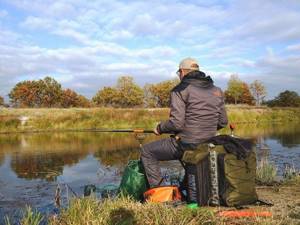
In addition to the necessary camouflage, this accessory relieves the load on the legs and allows you to have the necessary minimum of additional equipment on hand.
Feeding
For roach fishing, the correct bait is no less important than the correct gear. Many anglers ignore this rule and lose. In my understanding, bait for catching autumn roach must be dark, finely dispersed, and moderately active. Excessive aromatization of roach baits is more likely to cause harm. You can also use highly flavored baits left over from the summer, just sift them through a fine sieve several times and dilute them heavily with dark earth - the share of earth in my roach baits reaches 50-70%.
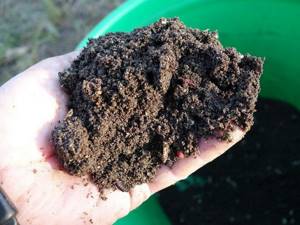
Of the imported dry mixtures, I most often use Sensas 3000 Super BLACK Canal, and of the domestic ones, Vabik, Black Roach.
To save precious fishing time, I do all the operations of soaking the dry mixture and adding earth to it at home. In a few hours, the bait has time to be properly saturated with water, and does not generate so much dust in the water. On the shore, all I have to do is add a live component to the bait and start fishing. The live ingredients I most often use are casters and dead maggots. Bloodworms are used less often, and chopped worms are almost never used. For some reason, in the fall, fish do not react to worms.
The most common tactics for feeding autumn roach are as follows. After determining the fishing point, I throw 2-3 tightly molded balls of bait the size of an apple into the water and start catching fish.
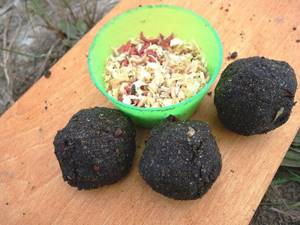
Even if there are no bites during the first half hour of fishing, I do not provide additional feeding. In the fall, it is very important to maintain the correct fishing pace, and untimely supplementary feeding can ruin fishing for a long time. Even after the fish starts feeding and regular bites begin, more often than at intervals: 15 minutes - the fish, I do not feed it. And then I use small balls of bait for this, the size of plums.
Catching bream in November with a float rod
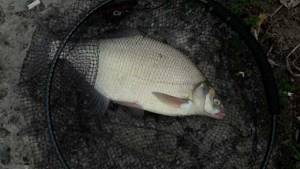
Bream gradually begins to get used to temperature changes and behaves a little more active than in early and mid-autumn. Even a light drizzle with a pressure difference is not a big obstacle to catching a trophy specimen. Despite the fact that it is becoming increasingly difficult to meet bream near the shore, as it moves away to wintering pits, it is still possible to catch it with float tackle. The most productive fishing will be on a boat. However, “on foot” anglers still have a chance to catch bream and hang them throughout the long winter. Read also: Ice fishing for bream with a fishing rod The best bait at the end of autumn will be a bunch of bloodworms or several maggots. You can also experiment with different types of “sandwiches” - maggot + bloodworm, maggot + worm, etc. In some places, bream also take well on mastyrka prepared from peas, semolina and corn flour. You can add a little honey, unrefined sunflower oil or vanillin as a flavoring.
For successful fishing in November, you will need bait prepared from a mixture of millet, crackers, rolled oats, sunflower cake, ground roasted hemp seeds, bloodworms and maggots. At the same time, the fraction of components included in the bait mixture should not be very small, otherwise the bream simply will not be interested in it. Some anglers claim that the plant components in November bait only interfere with good fishing. They use only dry soil with bloodworms, maggots and chopped worms added to it to feed bream.
From a boat, it is best to look for bream using an echo sounder. You can find a school of fish at depths of over 5 meters (most often at 6-10 meters). True, on warm days bream can also go to shallow depths, but this happens extremely rarely. Basically, bream will spin in the following places:
- at a depth near the pits that he chose as his future wintering site;
- near the rocks, where the depth begins immediately from the shore (here you can fish well not only from a boat, but also directly from the shore itself);
- at great and medium depths with a muddy or rocky bottom (it’s better not to try to fish on a sandy one, since you rarely even see bream there anymore).
Nozzles
The principle: what we feed is what we catch, it works very well for roach. If I use casters and maggots for bait, then I mainly fish with them.
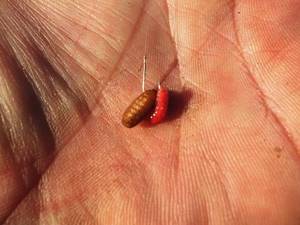
Sometimes fish respond better to brown bread dough or toast granules. Then, as bait, I use black bread mixed with soil, or bread crumbs rubbed through a sieve.
Nod
Another fishing option is also very interesting. A rig with a guard is attached to a fly or plug fishing rod, exactly the same as for fishing with a summer jig, but instead of a jig, a hook is placed, and a shot is placed 5–20 cm above the hook. The descent on the rig is set in such a way that the sinker hangs in close proximity to the bottom, and the hook with bait lies on the bottom soil.
If the bites are very careful, the equipment is light, and the current is strong, then the distance between the hook and the shot can be increased to a meter. It is important to remember to periodically raise and lower the rig very slowly. This not only gives the bait game, but also leads to its displacement to another point. It is well known that a roach, for example, can only peck at a certain point and not take a bloodworm that is a few centimeters to the side.
As for bait, in addition to the traditional bloodworms and maggots, it is worth stocking up on caddis flies and dragonfly larvae. At this time of year, very good results are obtained when using pieces of worm as bait, and even bleak bites on them. What to do with a catch consisting of a couple of dozen roaches, bleaks and minnows? Small deep-fried fish are very good, but if you don't want to bother with them, then you should try to catch burbot.
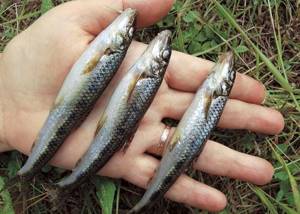
Fishing tactics
In autumn, the fish becomes inert, and is unlikely to chase even the most delicious bait if it swims half a meter from the feeding point, or its speed is greater than the current. Therefore, it is very important to learn how to slow down the equipment. This is where a stiff rod and short line come in handy. Having lowered the tip of the rod to the water itself, I constantly slow down the equipment, forcing the bait on the hook to slowly move at the very bottom.
As you can see, there is nothing difficult in catching autumn roach. So don’t waste time, and while it’s still warm, go with a float rod for autumn roach. I'm sure you won't regret it.
Live bait donks
If several small fish are caught, then you definitely need to throw in live bait . In the autumn, these tackles often work better than any spinning rod for pike, at least on a small river. It is clear that donks should be placed far to the side. A bell or a large feeder bell will indicate a bite. And if these donks are left overnight, then burbot can become prey.
I recommend to read:
Zherlitsy for a small river - The approach of spring.. Where to place the zherlitsy? What changes have to be made to the equipment of the vents? Why you shouldn't look...
Share with your friends!
